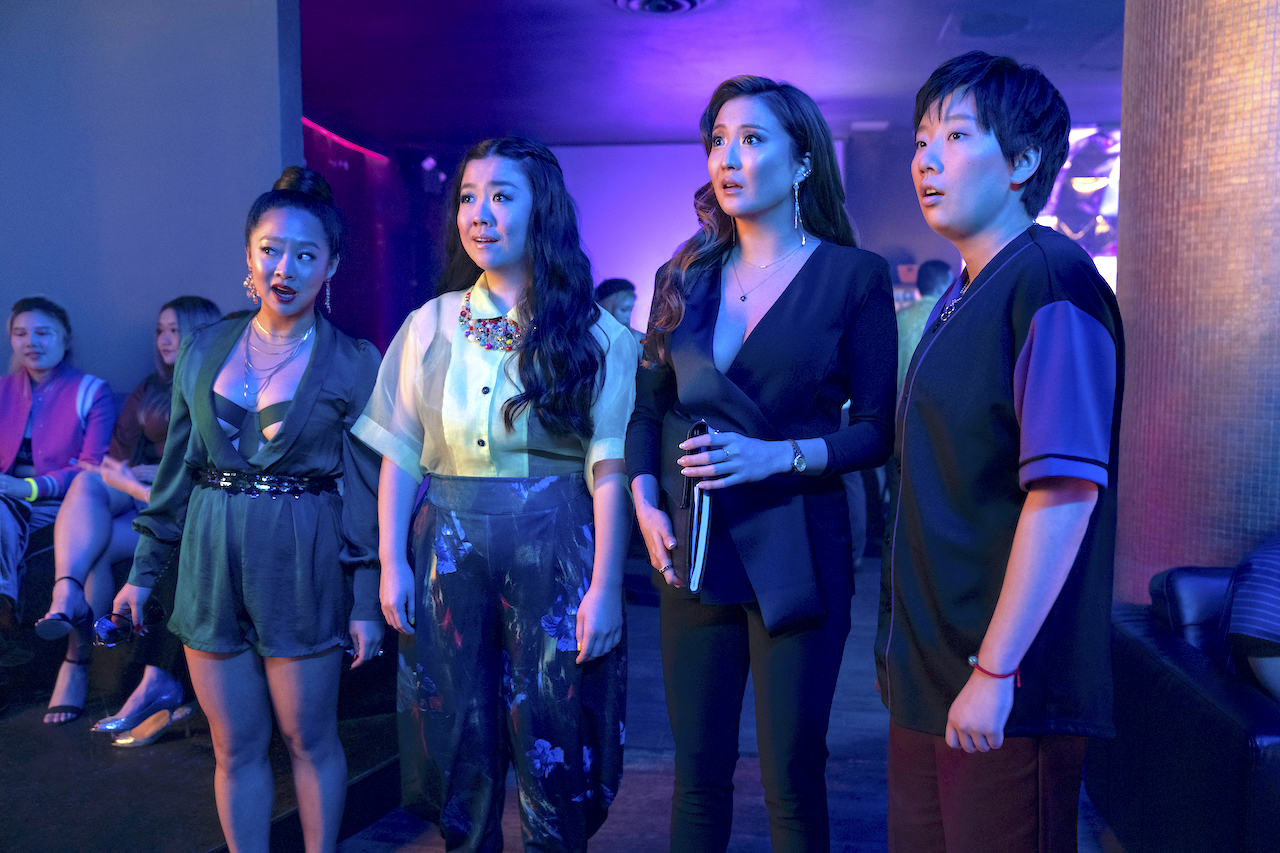After the stunning success of Crazy Rich Asians, Adele Lim had big Asian boots to fill in her raunchy followup film, R-rated comedy, Joy Ride. And fill them, she did with co-writers Teresa Hsiao (Family Guy, Awkwafina is Nora from Queens) and Cherry Chevapravatdumrong (Resident Alien, The Orville). Aside from the importance of representation on screen, Joy Ride is a hyperkinetic pastiche of Asian-Americans doing their crazy things – getting into mischief, getting out of mischief, and living their lives to the fullest. Cherry and Teresa spoke with Creative Screenwriting Magazine about their intention for their film. “We basically wanted to explore having fun and making each other laugh,” expounds Cherry without further thought. They didn’t try to overthink it.
The writers wrote Joy Ride on spec to tell the story about themselves they wanted to see while growing up. They sent their script to Seth Rogen’s Point Grey Pictures and Lionsgate who shepherded them through the production process.
Joy Ride contains the energy of a rollercoaster ride as the four friends Audrey (Ashley Park), Lolo (Sherry Cola), Deadeye (Sabrina Wu) and Kat (Stephanie Hsu) traverse two continents in a journey of friendship, self-discovery and awareness.
“We really wanted it to not only be a big comedy, but we also wanted it to have these emotional moments as well,” adds Teresa. “And so, in writing it, it was definitely a challenge in terms of bringing in the funny parts, but also make the characters be grounded, lovable, and relatable.” The writers spent considerable time pitching jokes and situations with Adele Lim, and the actors really elevated the material.
Cherry and Teresa are both producers on Joy Ride, which gives them say in the stylish editing and sound track. “We could make sure, in the editing process, that those scenes that we wrote were funny, but sometimes tear jerking. We balanced out the ebbs and flows to make sure that it was not “whiplashy” so that people could be very sad and very involved in the emotional character journey at one point, but then be laughing the next,” elaborates Cherry.
Despite the big laughs in Joy Ride, Chevapravatdumrong and Hsiao ironically didn’t set out to write a huge comedy piece with a sequential cannon of gags. It is more a sequence of set pieces. Cherry notes a K-pop scene where the friends are doing a Korean cover version of Cardi-B and Megan Thee Stallion’s W.A.P. “You can feel the audience leading forward and getting into that energy. So, even if maybe not at that second, it’s not a big laugh moment, but it’s still an energy moment. It’s like a hype up moment.”
This highlights the creative process of various creative elements coming together rather than facing the situation of a joke being funny on the page and hoping it will play the same way on the screen.
Writing the R-rated Comedy
Joy Ride ostensibly unfolds as the raucous coming of age story of four friends. We asked Hsiao and Chevapravatdumrong why they chose an R-rated vehicle with more than its fair share of ribald jokes to tell their story. Delights Teresa, “It was always gonna be an R-rated movie because I think our general comedy brains just went in there. I suppose we are disgusting and it had to be gross.” Both have written edgy, suggestive comedy on shows like Family Guy, but Joy Ride gave them the license to see characters do things they don’t normally see on screen. There was no mandate to push the envelope. The writers were simply being themselves.
“We’ve written for television before, but now to translate that comedy into a film is a totally different animal,” exclaims Teresa. “The original title for the movie was The Joy *uck Club,” chuckles Cherry. “That was basically the vibe and the tone that we were aiming for the entire time.”
Adele Lim was instrumental in the early story phases of the project. Adele, Teresa, and Cherry are all friends so they brainstormed ideas together. They put story beats on the board and broke the story together. Teresa and Cherry wrote the script. Adele doesn’t specifically have a comedy background, allowing her to use her expertise to dramatize certain scenes.
Despite the mayhem in Joy Ride, Teresa and Cherry had to carefully plot each character arc. “We actually had a big grid of each of the characters of where they started and where they ended up and how they interacted with each other. It was a big spreadsheet on a board with their names at the top and going down and how their interactions, motivations and actions would affect each other. Then we were able to play around with their dynamics,” says Teresa. “We make sure that everyone gets their own time, give them their own character quirks, but also give them a backstory.”
Movie Inspirations
Teresa and Cherry did their due diligence by researching previous R-rated comedies. “We’re big fans of The Hangover, Bridesmaids, and Girls Trip,” confirms Teresa. They also looked to Blockers and Good Boys to stimulate their comedic muse. These are movies about friendships in distress. The writers also cite American Pie as another influencer of Joy Ride.
“That is definitely something that we wanted to get across because friendship is universal. It’s something where I feel everyone can relate to at some point – having a friend, and then not getting along with a friend, and then trying to do some things with some friends, and it doesn’t go exactly as you planned,” adds Teresa.

Teresa Hsiao & Cherry Chevapravatdumrong. Photo by Casi Moss
These friendship movies are often built on ensemble casts. “We definitely wanted to have a variety of characters that different people could relate to. What’s been nice about these movies is that audiences all have a different favorite character. So, there’s lots of entry points for them.”
The seminal movie that compelled Teresa to write is Miss Congeniality. “I think we all probably have our own kind of movies in our own writing journeys that inspired us to want to be writers. Miss Congeniality is a fun comedy of the time and it feels like that kind of comedy isn’t made any more. Joy Ride takes that and makes it much raunchier, crazier, and more insane. It captures a spirit as opposed to a plot.”
The Changing Nature Of Friendship
The composition and evolving nature of friendships is explored in these types of movies. In Joy Ride, it’s about two friends Audrey and Lolo who grew up together and took very different paths in life. In fact, they confess that they probably wouldn’t be friends if they met as adults. Kat joined them to find her biological mother and Deadeye is Lolo’s relative.
Highlights Cherry, “We definitely wanted to play with the fact that as you get older you will have friends from different eras and parts of your life. They’re not just four friends who all grew up together all the same time.” Friends can drift apart and come together in new configurations. “Some people you knew way back know a slightly different version of you than some people who met you when you were a little bit older.”
The coming of age themes are also apparent in Joy Ride. “We’re getting a little older, growing up, and becoming an adult. The friends you have and how you relate to them differs from the way that you related to friends earlier in your life.”
Kat and Lolo are childhood friends “who’ve always stuck together. And yet, they’ve grown apart. Kat is successful and responsible and Lolo is stuck in her old ways. And so, Kat represents the friend that you would have as an adult. This is the friend that you have that is equally as successful; the one that you would gravitate towards now that you are doing better in your life.” Deadeye is an outlier because they’ve never had that big a group of friends.
“There’s your best friend growing up, your friend who is now the sort of person you wanna be, and there’s the hanger on. The cast brings this energy and heart into your life.” Hsiao and Chevapravatdumrong then explore how to make these character prototypes specific to them.
A film like Joy Ride has many moving parts until the final edit. The emotional core of Audrey’s identity journey of her search for her birth mother was always a constant. Some of the locations and set pieces changed along the way for practical reasons. In animation every set costs the same to create, but this isn’t the case in live action.
A Question Of Ethnic Identity
Joy Ride adds to its already dense thematics by raising questions of ethnic identity. Are they Asian-American or American-Asian? How much do they acclimate to their environs? Is there a place for everyone in the rich cultural tapestry of America?
Cherry and Teresa didn’t set out to specifically make a movie about “Asian-Americans” or “representation.” They were most interested in entertaining their audience. “This was going to be a story about these characters’ personalities and emotions. Identity was something that just came naturally out of who the characters were. It’s inherent in who we are. Everyone tackled it from their own experiences. It was already in the ether so it came from within us very naturally,” says Teresa.
Lolo and Audrey grew up in a predominantly white town, so they bonded through circumstance. Cherry grew up in such a town where her parents owned a Thai restaurant. “So, there were little pieces of the characters where we took from our own lives and that informed the characters,” says Teresa. We’re not making a statement about identity. We’re telling an authentic story through our lens.“
